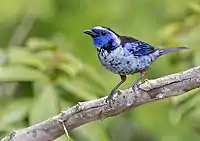| Opal-rumped tanager | |
|---|---|
 | |
| Scientific classification | |
| Domain: | Eukaryota |
| Kingdom: | Animalia |
| Phylum: | Chordata |
| Class: | Aves |
| Order: | Passeriformes |
| Family: | Thraupidae |
| Genus: | Tangara |
| Species: | T. velia |
| Binomial name | |
| Tangara velia | |
 | |
| Synonyms | |
|
Motacilla velia Linnaeus, 1758 | |
The opal-rumped tanager (Tangara velia) is a species of bird in the family Thraupidae. It is found in the Amazon and Atlantic Forest of South America. The population of the Atlantic Forest has a far paler chest than the other populations, and has often been considered a separate species as the silvery-breasted tanager (Tangara cyanomelas). Today most authorities treat it as a subspecies of the opal-rumped tanager.

Taxonomy
In 1743 the English naturalist George Edwards included an illustration and a description of the opal-rumped tanager in his A Natural History of Uncommon Birds. He used the English name "Red-belly'd Blue-bird" ". Edwards based his hand-coloured etching on a specimen owned by the Duke of Richmond that had been collected in Suriname.[2] When in 1758 the Swedish naturalist Carl Linnaeus updated his Systema Naturae for the tenth edition, he placed the opal-rumped tanager with the wagtails in the genus Motacilla. Linnaeus included a brief description, coined the binomial name Motacilla velia and cited Edwards' work.[3] Linnaeus provided no explanation for the specific epithet; it is perhaps a misprint for the Ancient Greek elea, a small bird mentioned by Aristotle.[4] The bay-headed tanager is now placed in the genus Tangara that was introduced by the French zoologist Mathurin Jacques Brisson in 1760.[5][6] The type locality is Suriname.[7]
Four subspecies are recognised:[6]
- T. v. velia (Linnaeus, 1758) – the Guianas and north Brazil
- T. v. iridina (Hartlaub, 1841) – west Amazonia
- T. v. signata (Hellmayr, 1905) – northeast Brazil
- T. v. cyanomelas (Wied-Neuwied, 1830) – east Brazil
References
- ↑ BirdLife International (2017). "Tangara velia". IUCN Red List of Threatened Species. 2017: e.T22722953A119558614. doi:10.2305/IUCN.UK.2017-3.RLTS.T22722953A119558614.en. Retrieved 12 November 2021.
- ↑ Edwards, George (1743). A Natural History of Uncommon Birds. Vol. Part 1. London: Printed for the author at the College of Physicians. p. 22, Plate 22.
- ↑ Linnaeus, Carl (1758). Systema Naturae per regna tria naturae, secundum classes, ordines, genera, species, cum characteribus, differentiis, synonymis, locis (in Latin). Vol. 1 (10th ed.). Holmiae (Stockholm): Laurentii Salvii. p. 188.
- ↑ Jobling, James A. (2010). The Helm Dictionary of Scientific Bird Names. London: Christopher Helm. p. 399. ISBN 978-1-4081-2501-4.
- ↑ Brisson, Mathurin Jacques (1760). Ornithologie, ou, Méthode Contenant la Division des Oiseaux en Ordres, Sections, Genres, Especes & leurs Variétés (in French and Latin). Paris: Jean-Baptiste Bauche. Vol. 1 p. 36 and Vol. 3 p. 3.
- 1 2 Gill, Frank; Donsker, David; Rasmussen, Pamela, eds. (July 2020). "Tanagers and allies". IOC World Bird List Version 10.2. International Ornithologists' Union. Retrieved 14 October 2020.
- ↑ Paynter, Raymond A. Jr, ed. (1970). Check-List of Birds of the World. Vol. 13. Cambridge, Massachusetts: Museum of Comparative Zoology. p. 386.
- Assis, Seixas, Raposo, & Kirwan (2008). Taxonomic status of Tangara cyanomelaena (Wied, 1830), an east Brazilian atlantic forest endemic. Revista Brasileira de Ornitologia 16(3): 232–239.
